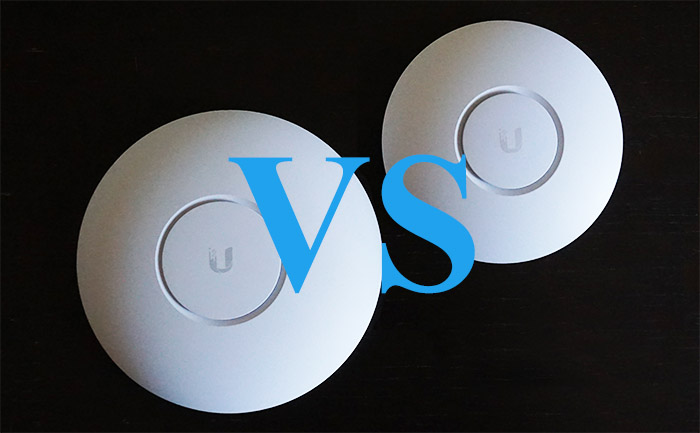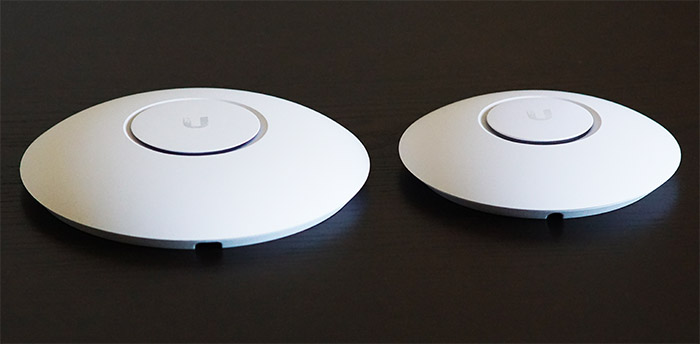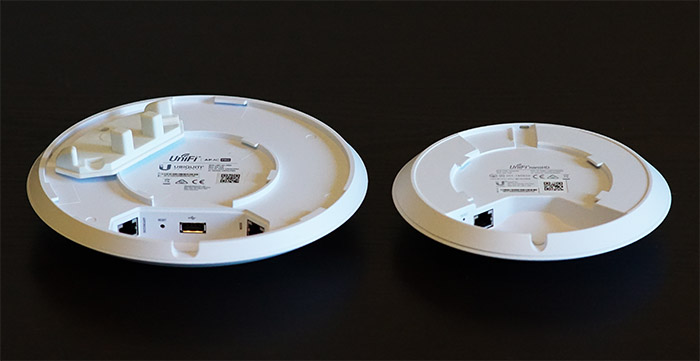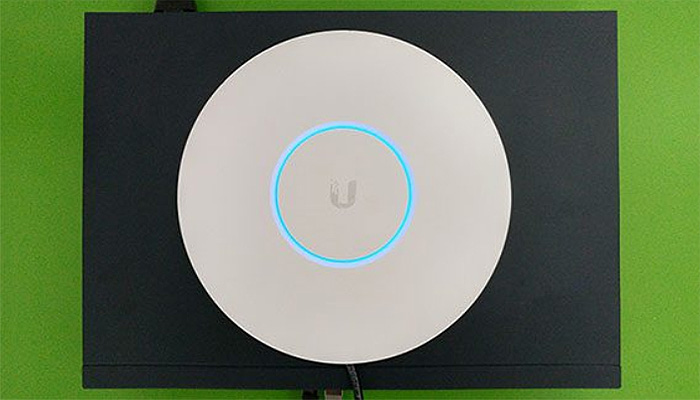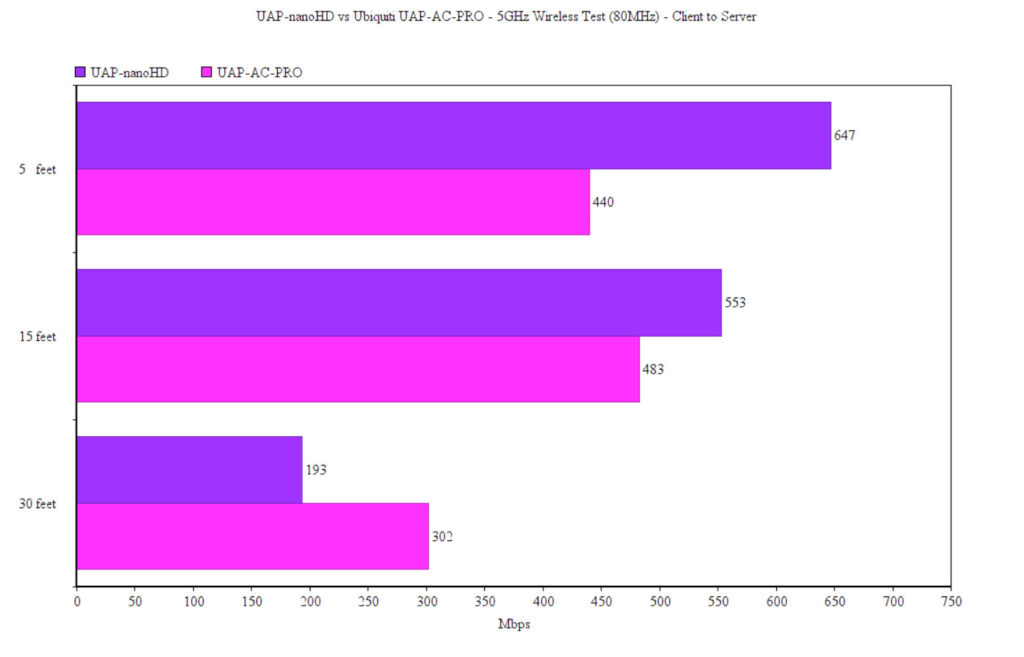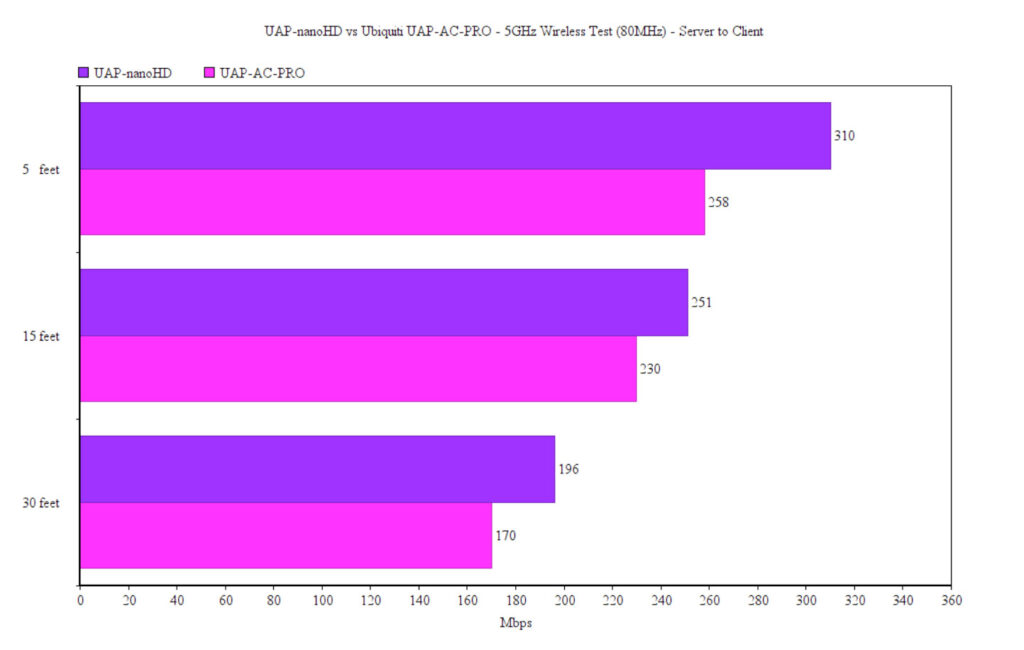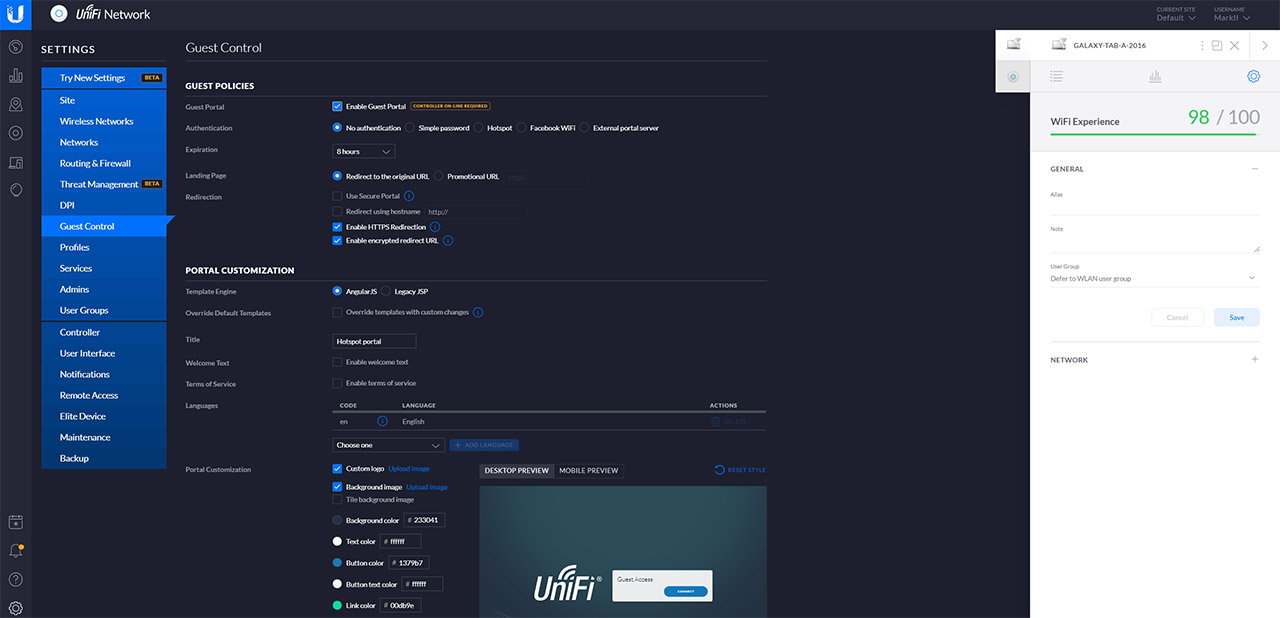Ubiquiti has been the go-to manufacturer for reliable SMB-level networking devices for almost a decade and the public has been especially fond of their wireless access point series (and surprisingly, Ubiquiti is a favored option even in the home networking market as well). One of the most popular models is the Ubiquiti UAP-AC-PRO (the predecessor of the NanoHD) which, for over four years has proven to be a reliable access point. But, while the wireless performance was stable, some users may want more from their Gigabit Internet connection (and some 802.11ac WAVE 2 features were missing), so an upgrade was necessary for a long time. That’s were the UAP-nanoHD comes into the scene and the device is more compact, delivers a better throughput, but it has lost its ability to be mounted outdoors.
| Ubiquiti UAP-AC-PRO | |
|---|---|
| Amazon.com | Check Product |
| Ubiquiti UAP-nanoHD | |
|---|---|
| Amazon.com | Check Product |
Furthermore, Ubiquiti migrated from Qualcomm to MediaTek and this has not gone unnoticed by the users which became skeptical whether the new wireless access point will be as stable as its predecessor and if it will last as long. Two years have passed since Ubiquiti launched the NanoHD and the manufacturer has released a lot of patches to fix the initial bugs and and some missing features have also been added. That being said, let’s put the Ubiquiti UAP-nanoHD and the UAP-AC-PRO next to each other and see the improvements that the manufacturer has made the last couple of years (and yes, the UAP-AC-PRO has been just as supported) and whether the UAP-nanoHD is at least as good as its predecessor.
Note: You can also check out the individual analysis of each access point here: Ubiquiti UAP-AC-PRO and Ubiquiti UAP-nanoHD.
Design and Build Quality
Since the beginning, Ubiquiti has been very serious about differentiating its access points from the rest of its competitors, so it designed the UAP series in a minimalist manner and no, the look of these devices hasn’t changed much over the years but that’s not really a bad thing since the saucer-shaped plastic case with the circular LED still looks brilliant on the ceiling. And indeed, the design of the UAP-AC-PRO is very much relevant even today, featuring a thin circular case covered by a white matte finish (the entire device measures 7.74 x 7.74 x 1.38 inches) which makes it more compact than the likes of Linksys LAPAC1750c or Zyxel NWA1123AC-HD. The Ubiquiti NanoHD looks the same as the UAP-AC-PRO, but the case is far smaller, measuring 6.30 x 6.30 x 1.29 inches and yes, both access points have the LED ring on the top (the UAP-nanoHD has it smaller, but seems a bit brighter due to the deeper canal). Furthermore, while the Ubiquiti UAP-AC-PRO is fully made of plastic, the NanoHD does have a plastic top (which feels softer to the touch), but the bottom part is made out of zinc alloy.
This decision has been made to help improve the heat dissipation since a more compact body and no cut-outs do mean that it’s going to have a harder time managing the internal temperature and I also noticed that the NanoHD feel heavier than the UAP-AC-PRO (although it’s not, the former weighs 0.77 lbs, while the latter only 0.66 lbs). The Ubiquiti UAP-AC-PRO was built to be suitable for indoors, as well as some outdoor conditions (it shouldn’t be kept on a pole in the open, but it should be fine while mounted on the outer wall of a shed), so the case is completely sealed off, including the ports area which has a silicone cover to allow only a couple of cables to go through. This means that the device can easily reach a higher temperature and indeed, the access point runs a bit hotter than some devices from the competition (although there was no overheating and I experienced no throttling). You will not be able to put the Ubiquiti AP-nanoHD outdoors since it has no protection against water and dust ingress and I noticed that it also functions warmer than some other access points, especially on the bottom, where the area can get hot to the touch.
Both the Ubiquiti NanoHD and the UAP-AC-PRO are designed to be mounted on the wall or ceiling (there is a mounting kit inside the package – the NanoHD also provides a PoE adapter), so don’t expect any silicone feet on the bottom of any device to keep it on a desk and instead, there is the section to mount the bracket, as well as a small canal for the cable/s. Of course, there is also a carved-in area for the ports and the UAP-AC-PRO offers two Gigabit Ethernet ports for the connection to the PoE adapter / switch / gateway (802.3af) and for an additional wired client; there’s also a Reset button and a USB type-A port for diagnostic purposes. Unlike the UAP-AC-PRO, the UAP-nanoHD offers only a single Gigabit Ethernet port (PoE+ 802.3af) and a Reset button which kind of makes sense for a ceiling access point, but it still robs the user from having more options (for example, the UAP-AC-PRO easily allows you to connect an IP camera, while the NanoHD does not).
Lastly, the single LED on both wireless access points has the same role to show the status of the connection and of the device: if the LED is solid blue, then the access point is working properly and it will flash blue every couple of seconds while it’s booting up; if it’s flashing fast, then the AP is in an isolated state.
Verdict: I really like that the UAP-nanoHD is very compact and the fact that it comes with a PoE adapter, it’s a big bonus, but there are some elements that are missing from its predecessor, such as the additional Ethernet port and the water-protection. That being said, if you’re going to put the access point indoors and don’t have any wired client nearby, the NanoHD wins hands down, but, if you need an access point that can survive some mild outdoor conditions and do need to connect a wired client, then the UAP-AC-PRO is the better device which means that this round is a tie.
Internal Hardware
In order to open up any of the two models, you will have to use a prying tool kit and carefully move around the case until the top part pops off (there are no screws, just the plain old plastic hinges – make sure not to break them) – be aware that doing so will most likely void the warranty. Inside the Ubiquiti NanoHD, I was able to identify a dual-core Mediatek MT7621AT MIPS CPU clocked at 880MHz, 128MB SDRAM DDR3 (Winbond W632GG6MB-15) and 32MB of NOR flash memory (MXIC MX25L25635FMI-106); for the WiFi, the wireless access point relies on the Mediatek MT7603EN for the 2.4GHz band (802.11b/g/n) performance and on the Mediatek MT7615N for the 5GHz band (802.11ac) WiFi performance.
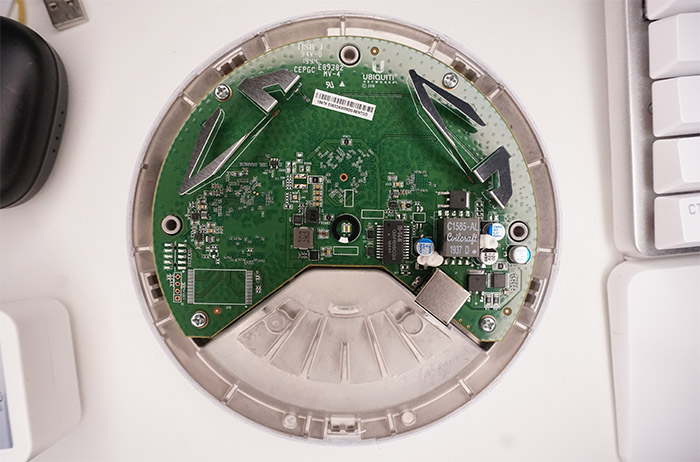
The Ubiquiti UAP-AC-PRO comes equipped with Qualcomm Atheros QCA9563 MIPS chipset clocked at 750 MHz, it has 128 MB of RAM, 16 MB of NOR flash memory and there’s also a Qualcomm Atheros AR8337 switch chip. For the WiFi, the access point relies on the Qualcomm Atheros QCA9880 chipset for the 5GHz radio (802.11a/n/ac) and on the Qualcomm Atheros QCA9563 b/g/n for the 2.4GHz radio. Furthermore, the UAP-AC-PRO features a maximum theoretical data transfer rate of 1,300 Mbps on the 5GHz band and 450 Mbps on the 2.4GHz band (which makes it an AC1750-class networking device). The UAP-nanoHD features a maximum theoretical data transfer rate of 1,733 Mbps on the 5GHz band and a maximum of 300 Mbps on the 2.4GHz band (so, it’s an AC2000-class AP).
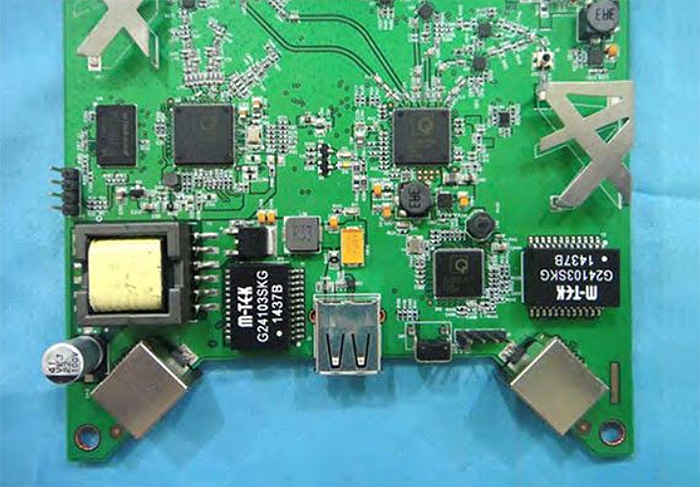
Verdict: It’s obvious that the Ubiquiti NanoHD is better equipped than its predecessor, but is the performance and most important, the stability of the access point actually better? It’s true that the NanoHD had some initial bugs, but Ubiquiti has fixed them over the past two years and it seems that most users are quite satisfied with the UAP-nanoHD, so yes, it is indeed better than the UAP-AC-PRO from the internal hardware point of view (it’s worth mentioning that the UAP-AC-PRO may have a slight advantage with the 2.4GHz clients).
Features and Wireless Performance
You’re probably familiar with the WiFi systems that have multiple, usually identical units that can communicate wirelessly and cover a larger area with WiFi (there’s Google WiFi, Eero WiFi or Netgear Orbi). The Ubiquiti UniFi access points can do the same thing by relying on a similar implementation of the mesh technology (Ubiquiti calls it Uplink) and the concept is the same: connect one UAP to the router using an Ethernet cable and the rest of the access points can be spread out inside a larger office, pushing the data from one node to the other relying on the WiFi connection (be aware that one AP supports only up to four wireless downlinks). Although quite useful for some applications, I would advise against setting up a multi-hop system since the backhaul traffic will become too heavy for the couple of bands available on either the UAP-AC-PRO or the UAP-nanoHD. Besides the Uplink feature, the two access points also have in common the support for the Fast Roaming and yes, it is very similar to the Fast BSS Transition, but Ubiquiti has tweaked it in such a fashion as to work with all clients, removing the compatibility issue for the technology in its default state.
The Fast Roaming is going to be useful only if you have deployed more than one access point since it allows the user to roam from one AP to the other without experiencing any disconnections – the reason for that is because the initial handshake is done between the devices before the client starts roaming, so it doesn’t have to re-authenticate at every node. Some features that are missing on the UAP-AC-PRO, but have been added on the NanoHD are the MU-MIMO support and the BeamForming technology. MU-MIMO is useful if you have compatible clients (most people do not) and it will allow multiple clients to be served at the same time (instead of the road-robin technique used by MIMO devices); BeamForming is useful for reducing the amount of interference since the signal is going to be focused directly towards the compatible clients, instead of being broadcasted everywhere hoping that it will reach the client devices.
I have tested the Ubiquiti UAP-AC-PRO a few years back and, since not much has happened during this time (no wireless performance enhancing updates), I will use the results that I got with a client equipped with an Asus PCE-AC88 WiFi adapter (the best in its class at that time). I have tested the NanoHD quite recently using a client equipped with a TP-Link AX3000 WiFi adapter (AC mode) and, considering that neither access points can push these two PCIe adapters to their maximum, we should see pretty much identical results regardless of which one is used. That being, said, the setup is the same: one computer is going to act as the server and will connect to an unmanaged PoE Ethernet switch (I used a TRENDnet TPE-LG80) and another computer will be the client and will connect to the access point via wireless. First, it’s going to be the Ubiquiti UAP-AC-PRO and I connected the client device to the 5GHz network (80MHz since it can’t go higher) and, from the client to the server, at 5 feet, I saw an average of 440 Mbps, while at 30 feet, it was an average of 302 Mbps.
From the server to the client, the throughput was a bit lower (as expected), so, at 5 feet, I saw an average of 258 Mbps and, at 30 feet, it was around 170 Mbps. As the next test, I connected the client to the 2.4GHz network (40MHz) and, from the client to the server, I measured an average of 107 Mbps and, at 30 feet, I got an average of 106 Mbps. The Ubiquiti UAP-nanoHD performed a bit better on the 5GHz network (80MHz), so, from the client to the server, at 5 feet, I measured an average of 647 Mbps and, at 30 feet, I got around 193 Mbps. From the server to the client, I measured an average of 310 Mbps at 5 feet and an average of 196 at 30 feet. Yes, the device supports 160MHz channel bandwidth, but the UAP-AC-PRO does not, so if you’re curios about the results, you can check them in the full NanoHD review (here, you can also see the results when using a client equipped with an Intel 8265 adapter). Lastly, I switched to the 2.4GHz network (40MHz) and, from the client to the server, I measured an average of 182 Mbps at 5 feet, while at 30 feet, I saw an average of 70.5 Mbps.
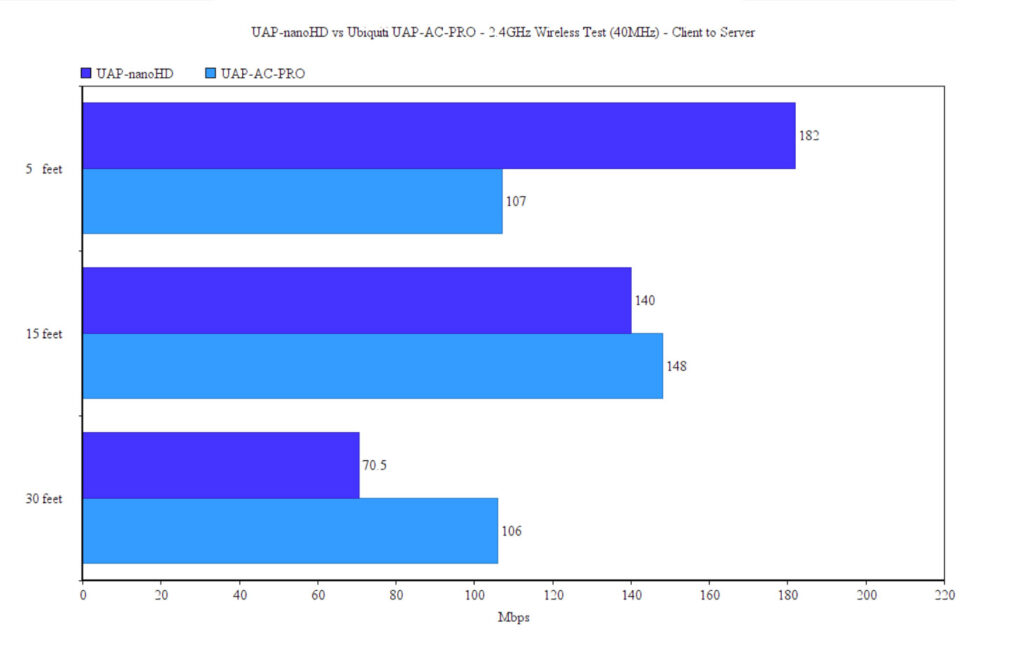
Verdict: The Ubiquiti UAP-AC-PRO did quite well at the long-range test on the 5GHz band, but on everything else, the UAP-nanoHD performed better; there’s also the MU-MIMO support, so it wins this round.
Setup and Software
The setup process for either devices should be identical and the only difference can be how long it takes until the installation is complete (even though it’s a difference of a few seconds, so barely noticeable). That being said, you will need to install the UniFi controller on a computer (or even better, on a NAS) which should run uninterrupted – you also get the option to rely on the Ubiquiti Cloud server (which is subscription based, but it does offer better features and more flexibility). After installing the controller, you can simply continue configuring the device on the host computer or you can install the UniFi app and connect it to the controller. The advantage of using the app is that the settings and options are grouped to match the wireless access point, while the UniFi controller has dedicated sections for each compatible device (WAPs, gateways and managed switches). Furthermore, you can adjust the settings for the wireless access point in a general sense (the SSIDs, adjust the radio settings, the Guest network and more) and then you can apply these changes to some or all compatible devices.
Verdict: The UniFi controller is going to offer the same experience using either the UAP-AC-PRO or the UAP-nanoHD, so expect the intuitive client control, the configuration box on the right side of the page (with multiple layers of control) and there’s also the comprehensive Guest Control section, where you can adjust the look of the splash page, the authentication mode (it supports a large array of options) and the redirection. For this reason, this round ends in a tie.
Note: If you want to read a more in-depth analysis of the UniFi controller, you can check it out on the full Ubiquiti NanoHD review or the full UAP-AC-PRO article.
Conclusion
The entire UAP series has done very well due to decent hardware supported by the excellent UniFi platform and this remains true for both the Ubiquiti UAP-AC-Pro and the NanoHD and, if I were to choose the better device, it’s very tempting to immediately go for the newer device since new means better, right? In this case, it does seem so, since the wireless performance is mostly better (there is support for the 160MHz channel bandwidth), it has proven to be stable in the long term (the fear that the MediaTek chips will behave inferior to the Qualcomm seems to have been unfounded) and the case is smaller which is always a positive design trait. Yes, you do lose the water and dust resistance and an additional Ethernet port, but I am sure only a few people will need these features – if you’re among these people, the UAP-AC-PRO is still a very relevant device, even in 2020.

